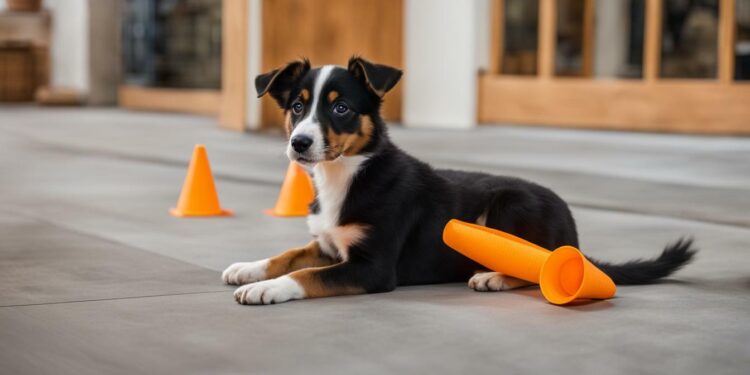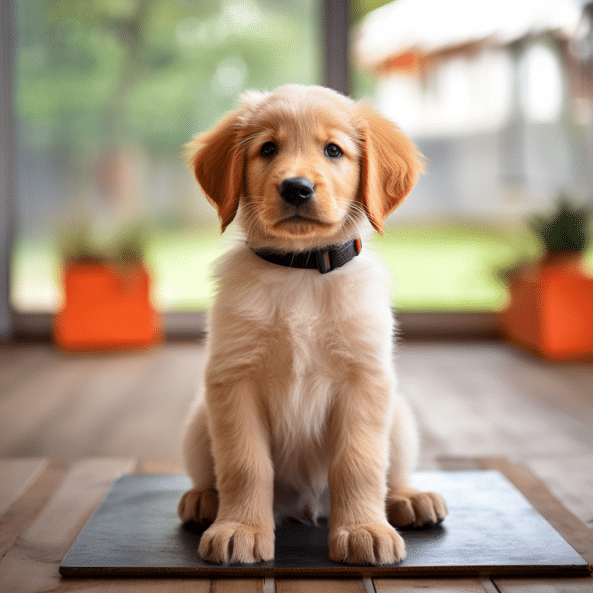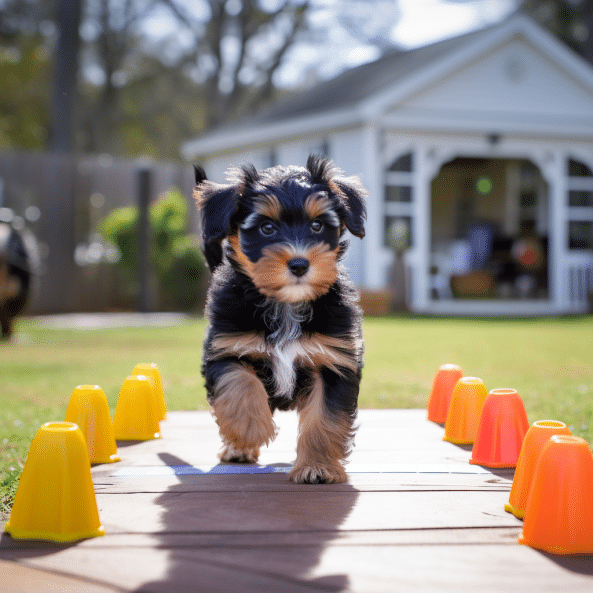Puppy Training Guide

Puppy Training Guide: Puppy training is an essential aspect of building a well-behaved and obedient pup. It is important to have realistic expectations for your dog’s behavior during the training process. While it’s natural to want your puppy to be happy and well-behaved, it’s unrealistic to expect them to be perfect right from the start.
Some common unreasonable expectations include expecting a dog to be happy after being crated for long periods, expecting them to be well-behaved with little enrichment, and expecting them to always be in a good mood. It’s also unrealistic to expect a dog to never leave your side or to tolerate things that you wouldn’t tolerate. Dogs have their own needs and behaviors, and it is important to understand and accommodate them during the training process.
Allowing puppies to exhibit their natural behaviors is also crucial. Dogs shouldn’t be expected to only do things when given permission. They should be allowed to explore, play, and express themselves within safe boundaries, fostering a healthy and well-rounded development.
Consistency in commands and expectations is vital for successful puppy training. Dogs thrive on routine and clear guidance. By providing consistent commands and expectations, you can establish a strong foundation for their learning and development.
Positive reinforcement techniques are highly effective in puppy training. Rewarding good behavior encourages your pup to repeat it and strengthens the bond between you. This positive training approach leads to better results and creates a harmonious training environment.
Crate training can also be beneficial for puppies. It provides them with a safe and secure space to retreat to, while also assisting in potty training and preventing destructive behaviors. Introducing the crate in a positive and gradual manner is key to its success.
Socializing your puppy is crucial for their overall well-being and behavior development. This includes exposing them to various people, animals, and environments in a positive and controlled way. Proper socialization helps prevent fear and aggression issues, resulting in a confident and well-adjusted pup.
Obedience training is a fundamental aspect of raising a well-behaved pup. Teaching basic commands such as sit, stay, and come ensures their safety and allows for better control in various situations.
Addressing common behavior challenges is inevitable during puppy training. Understanding why these challenges occur and implementing effective strategies will help overcome them and ensure a positive training experience for both you and your pup.
Leash training and recall commands are essential for having a well-behaved dog during walks and outdoor activities. Teaching your pup to walk nicely on a leash and come when called provides them with the freedom to explore while still maintaining control.
Advanced training techniques can enhance your pup’s skills and obedience. As they progress in their training, introducing more complex exercises and tasks can keep them engaged and mentally stimulated.
Maintaining a positive and rewarding training environment is crucial for your pup’s motivation and progress. Consistently praising and rewarding good behavior will encourage them to continue learning and performing well.
Consistency and patience are key throughout the puppy training process. It takes time and effort to build a well-behaved pup, and staying patient during setbacks or challenges will ultimately lead to better results.
In conclusion, puppy training plays a vital role in building a well-behaved and happy pup. Understanding and accommodating their needs and behaviors, setting realistic expectations, and implementing positive reinforcement techniques are essential for successful training. With consistency, patience, and the right approach, you can raise a pup that is obedient, well-mannered, and a joy to be around.
Setting Realistic Expectations for Puppy Training

Setting realistic expectations for your puppy’s behavior is crucial. Puppies are learning and developing, so expecting instant mastery of commands is unrealistic and leads to frustration. Avoid expecting a dog to be happy crated for long periods; gradual, positive crate introduction is essential. Another misconception is expecting perfect behavior without enrichment—puppies need mental and physical stimulation. Understanding dogs have moods and giving them space is vital. Unfairly expecting constant good moods strains your bond. Embrace their individuality, and, with patience, create an environment where they can thrive, learn, and become well-behaved companions.
| Unreasonable Expectations in Puppy Training |
|---|
| Expecting a dog to be happy after being crated for long periods |
| Expecting a dog to be well-behaved with little enrichment |
| Expecting a dog to always be in a good mood or never leave your side |
In conclusion, setting realistic expectations for your puppy’s behavior and progress during training is essential for a positive and successful training experience. Understanding that puppies are still learning and require patience, consistency, and appropriate enrichment activities will help foster a well-behaved and happy pup. By accommodating their needs and behaviors, you can create a strong bond with your furry companion and set them up for a lifetime of good behavior and obedience.
Understanding Common Unreasonable Expectations
It’s important to recognize and understand common unreasonable expectations that can hinder successful puppy training. Puppy training is a process that requires patience, consistency, and a realistic understanding of what is achievable. Expecting a dog to be happy and content after being crated for long periods of time is unrealistic. Dogs need regular exercise, mental stimulation, and social interaction to thrive.
Another common expectation is for a dog to be well-behaved without proper enrichment. Dogs are intelligent creatures that require mental and physical stimulation to prevent boredom and develop good behavior. Without adequate enrichment activities, dogs may become destructive or develop behavioral issues.
Additionally, expecting a dog to always be in a good mood is unrealistic. Dogs, like humans, have off days and may exhibit behaviors that are not ideal. It’s important to remember that they have emotions and may react differently to certain situations. Being understanding and patient with your dog during these times is essential for their overall well-being and training progress.
| Unrealistic Expectations | Impact on Puppy Training |
|---|---|
| Leaving a dog crated for extended periods | Inadequate exercise and socialization |
| Lack of enrichment activities | Boredom, destructive behavior |
| Expecting a dog to be happy all the time | Unrealistic emotional expectations |
Lastly, it’s unrealistic to expect a dog to never leave your side or tolerate things that you wouldn’t tolerate. Dogs have their own preferences and boundaries, just like humans do. Respecting their individuality and allowing them to have some independence during training can lead to a stronger bond and more successful training outcomes.
In conclusion, recognizing and understanding common unreasonable expectations in puppy training is crucial for building a well-behaved pup. Providing appropriate exercise, mental stimulation, and socialization, while understanding and respecting your dog’s individual needs and behaviors, are key factors in successful training.
The Importance of Enrichment in Puppy Training
Enrichment plays a crucial role in puppy training by promoting their mental and physical well-being. It involves providing puppies with stimulating activities and experiences that cater to their natural instincts and behaviors. By incorporating enrichment into their training routine, you can create a fulfilling and engaging environment for your puppy, which can have a positive impact on their behavior development.
One way to enrich your puppy’s training is through the use of interactive toys and puzzles. These toys not only provide mental stimulation but also encourage problem-solving skills and promote focus and concentration. Additionally, incorporating different textures, sounds, and scents into their environment can help broaden their sensory experiences and prevent boredom.
Another essential aspect of enrichment is socialization. Exposing your puppy to various people, animals, and environments from an early age can help them develop confidence and appropriate social behaviors. It also helps prevent fear or aggression towards unfamiliar situations, making them more adaptable and well-adjusted in different settings.
When it comes to enrichment, it’s essential to remember that each puppy is unique and may have different preferences and sensitivities. It’s important to observe their reactions and adjust the activities accordingly to ensure a positive and rewarding experience.
| Enrichment Activities | Description |
|---|---|
| Scent Training | Hide treats or toys and encourage your puppy to use their sense of smell to locate them. This activity stimulates their natural hunting instincts. |
| Agility Training | Set up a small obstacle course with tunnels, ramps, and jumps to challenge your puppy’s physical abilities and promote coordination. |
| Food Dispensing Toys | Provide toys that require your puppy to work for their food, such as treat-dispensing puzzles or food-stuffed Kong toys. |
By incorporating enrichment activities into your puppy’s training routine, you can create a well-rounded and fulfilling experience that goes beyond basic obedience. Remember to introduce new activities gradually and always prioritize your puppy’s safety and well-being.
Allowing Natural Behaviors During Training
Allowing puppies to express their natural behaviors fosters a holistic and effective training experience. It is essential to understand that dogs have innate instincts and behaviors that are deeply ingrained in their nature. By acknowledging and accommodating these behaviors, we can create a positive training environment that promotes learning and obedience.
One important aspect of allowing natural behaviors during training is to avoid suppressing or punishing behaviors that are natural for dogs. For example, dogs have a natural instinct to sniff and explore their environment. By allowing them to engage in sniffing and exploring during training sessions, we can tap into their natural curiosity and use it to reinforce obedience commands. This approach not only keeps training sessions engaging and enjoyable for the puppy but also helps them associate positive experiences with following commands.
In addition to encouraging natural behaviors, it is crucial to set appropriate boundaries and provide clear guidance. This can be achieved by using consistent commands and cues, reinforcing positive behavior with rewards, and redirecting unwanted behaviors. By establishing structure and consistency in training, puppies can develop a strong foundation of obedience while still being able to express their natural instincts and behaviors.
| Benefits of Allowing Natural Behaviors |
|---|
| Enhances the bond between owner and puppy |
| Increases the dog’s confidence and sense of security |
| Improves the overall training experience |
| Promotes mental and physical stimulation |
By embracing and understanding a puppy’s natural behaviors, we can create a balanced training approach that respects the dog’s needs while instilling essential obedience skills. Remember, training a well-behaved pup goes beyond suppressing natural behaviors; it involves fostering an environment of trust, guidance, and positive reinforcement. Through consistency, patience, and a focus on the dog’s well-being, we can achieve long-lasting results and raise a happy and disciplined companion.
Consistency in Commands and Expectations
Consistency in commands and expectations is vital for successful puppy training and obedience. Dogs thrive on routine and clear communication, making it essential to establish consistent commands and expectations from the start. When training your puppy, it’s important to use the same cues and signals for specific behaviors, such as sit, stay, and come. This consistency helps your puppy understand what is expected of them and allows them to develop a solid foundation of obedience.
One effective way to maintain consistency is by using positive reinforcement techniques. Rewarding your puppy with treats or praise when they follow a command correctly reinforces the desired behavior. It’s crucial to reward your pup immediately after they perform the behavior correctly, as this helps them associate the action with the reward.
Another aspect of consistency is maintaining the same expectations across different environments. Dogs can sometimes struggle to generalize commands from one setting to another. For example, if your puppy knows how to sit in your living room but fails to understand the command in the park, it might be because the cues and expectations are not consistent. Consistently practicing commands in various locations helps your puppy understand that the same rules apply no matter where they are.
Using a Training Schedule
A helpful tool for maintaining consistency in training is to create a training schedule. This schedule ensures that you set aside dedicated time every day to work on obedience training with your puppy. Consistency in training sessions helps reinforce the commands and reinforces their importance. It’s recommended to keep training sessions short and frequent, as puppies have shorter attention spans. By sticking to a regular schedule, you establish a routine that your puppy will come to anticipate, making the training experience more effective and enjoyable for both of you.
| Training Schedule Example: | Duration: |
|---|---|
| Morning Session | 10 minutes |
| Afternoon Session | 10 minutes |
| Evening Session | 10 minutes |
Remember, consistency in commands and expectations is a key factor in shaping your puppy’s behavior and promoting obedience. By establishing clear rules and maintaining a consistent training schedule, you can help your puppy become a well-behaved and obedient companion.
Positive Reinforcement Techniques in Puppy Training
Positive reinforcement techniques are proven to be highly effective in shaping desired behaviors during puppy training. These techniques involve rewarding and praising your pup for exhibiting the desired behavior, which encourages them to repeat it in the future. Unlike punishment-based methods, positive reinforcement focuses on rewarding good behavior rather than punishing bad behavior.
A common positive reinforcement technique is using treats to reward your puppy when they follow a command or display the desired behavior. This creates a positive association in their mind, making them more likely to repeat the behavior in order to receive the treat. It’s important to choose small, tasty treats that your puppy finds rewarding. You can also use verbal praise, such as saying “good boy” or “good girl” in an enthusiastic tone, as an additional form of positive reinforcement.
In addition to treats and verbal praise, you can incorporate other forms of rewards into your puppy training. This could include playtime with a favorite toy, access to a special sniffing area, or a short walk as a reward for good behavior. By using a variety of rewards, you can keep your puppy engaged and motivated during training sessions.
| Benefits of Positive Reinforcement Techniques in Puppy Training |
|---|
| 1. Builds a strong bond between you and your puppy. |
| 2. Increases your puppy’s confidence and trust in you. |
| 3. Creates a positive and enjoyable training experience for your puppy. |
| 4. Fosters a happy and well-behaved pup. |
Remember, consistency is key when using positive reinforcement techniques. Be clear and consistent with your commands, rewards, and expectations. Set realistic goals for your puppy and celebrate their progress along the way. With patience, consistency, and positive reinforcement, you can shape your puppy into a well-behaved and happy companion.
Crate Training and its Benefits
Crate training is a valuable tool with various benefits for puppies. It aids in housebreaking by tapping into dogs’ natural aversion to soiling their living space. The crate serves as a secure den-like area, fostering a sense of security and ownership for your puppy. This contributes to bonding and provides a retreat during stress. Additionally, crates prevent destructive behavior, limiting access to potential hazards. Crucially, crate training should always be positive, associated with treats and toys. Gradual introduction, coupled with ample stimulation outside the crate, ensures a rewarding experience, creating a safe, positive space for both you and your furry friend.
| Benefits of Crate Training: |
|---|
| Facilitates housebreaking |
| Creates a sense of security |
| Prevents destructive behavior |
Socializing Your Puppy
Socializing your puppy is crucial for balanced development. Start early, exposing them to diverse experiences positively. Gradual exposure ensures confidence without overwhelming. Customize the process based on your puppy’s uniqueness. Consistent, positive socialization fosters a well-behaved and confident adult dog.
“Socializing your puppy is like giving them the key to a happy and fulfilling life. It sets the foundation for positive interactions and helps them navigate the world with confidence and ease.” – Dr. Sarah Thompson, Veterinarian
Now let’s take a look at a table summarizing the key aspects of socializing your puppy:
| Aspect | Importance |
|---|---|
| Early Start | Starting socialization early helps puppies develop positive associations and prevents fear or anxiety towards new experiences later in life. |
| Positive Reinforcement | Rewarding desirable behaviors during socialization helps puppies associate new experiences with positive outcomes, promoting confidence and a willingness to explore. |
| Gradual Exposure | Gradually exposing puppies to new environments and situations helps prevent overwhelming them, allowing them to build confidence and adjust at their own pace. |
| Individualized Approach | Understanding and accommodating your puppy’s unique temperament and needs ensures a tailored socialization process that maximizes their comfort and growth. |
Obedience Training Basics for Puppies
When it comes to raising a well-behaved puppy, obedience training is paramount. Teaching your puppy basic commands and behaviors not only helps establish a strong bond between you and your furry friend but also ensures their safety and the well-being of those around them. In this section, we will cover the fundamental aspects of obedience training for puppies, including basic commands and techniques.
Basic Commands and Techniques
Start your puppy’s training early with crucial commands like Sit, reinforcing with treats or praise. Establish control and safety with Stay, gradually extending its duration. Teach the vital Come command for recall, rewarding with treats and encouragement. Consistency is key—use positive reinforcement techniques, such as treats, praise, and affection. Stay patient and maintain consistency in your commands and expectations.
Puppies thrive on repetition and positive experiences, so make training sessions enjoyable for them. By instilling these commands early, you’re not just building obedience but also creating a foundation for a joyful and engaging learning experience for your furry friend.
| Command | Technique |
|---|---|
| Sit | Hold a treat above your puppy’s head and gradually move it backward. As their head follows the treat, their bottom will naturally lower into a sitting position. Reward them with the treat and verbal praise. |
| Stay | Start by asking your puppy to sit. Once they are in a sitting position, hold your hand out, palm facing them, and say “stay.” Take a step back and then return to them, gradually increasing the distance and duration of the stay. |
| Come | Crouch down and excitedly call your puppy’s name followed by the command “come.” Use enthusiastic praise and reward them with treats upon reaching you. Gradually increase the distance between you and your puppy. |
| Leave it | Hold a treat in your closed fist and present it to your puppy. When they show interest, say “leave it” and wait for them to divert their attention. Once they do, reward them with a different treat and praise. |
| Drop it | Offer your puppy a toy or object they enjoy. When they have it in their mouth, say “drop it” and show them a treat. When they release the object, reward them with the treat and verbal praise. |
Addressing Common Behavior Challenges in Puppy Training
When it comes to puppy training, it’s important to anticipate and address common behavior challenges that may arise. By being proactive and understanding the reasons behind these challenges, you can effectively overcome them and ensure a successful training experience for both you and your furry friend.
Common Behavior Challenges
Here are some of the most common behavior challenges you may encounter during puppy training:
- Excessive Barking: Puppies may bark excessively due to boredom, fear, or seeking attention.
- Chewing: Puppies explore the world through their mouths, resulting in chewing habits that may damage your belongings.
- Jumping: Puppies often jump to greet people or express their excitement, which can become a nuisance behavior.
- Potty Accidents: House training can be a challenge for puppies, leading to potty accidents indoors.
- Leash Pulling: Puppies may pull on the leash during walks, making it difficult to have enjoyable and controlled strolls.
Strategies to Overcome Challenges
To address these behavior challenges, it’s crucial to implement the right strategies and techniques. Here are some tips to help you overcome common puppy training challenges:
- Consistency and Positive Reinforcement: Establish consistent rules and use positive reinforcement techniques, such as treats and praise, to encourage desirable behavior.
- Redirect and Distract: When your puppy engages in unwanted behaviors, redirect their attention to an appropriate activity or toy.
- Proper Socialization: Expose your puppy to various environments, people, and other animals from an early age to promote positive social behaviors.
- Patience and Persistence: Remember that puppy training takes time and patience. Stay consistent with training efforts and persistently reinforce desired behaviors.
- Seek Professional Help: If you’re facing significant challenges or struggling to train your puppy, consider seeking guidance from a professional dog trainer who specializes in behavior modification.
By applying these strategies and adapting them to your puppy’s specific needs, you can effectively address common behavior challenges and create a harmonious relationship with your furry companion.
| Behavior Challenge | Strategies to Overcome |
|---|---|
| Excessive Barking | Establish a quiet command and reward calm behavior. Provide mental and physical stimulation to reduce boredom. |
| Chewing | Provide appropriate chew toys and discourage chewing on inappropriate items by redirecting to approved toys. |
| Jumping | Teach your puppy alternative greetings, such as sitting, and reward calm behavior. |
| Potty Accidents | Establish a consistent potty routine, supervise your puppy closely, and reward successful elimination in the appropriate area. |
| Leash Pulling | Use positive reinforcement to encourage loose leash walking and consider professional training techniques. |
Leash Training and Recall Commands
Gradually introduce the leash positively, teaching them to walk calmly beside you. Introduce recall commands like “come” with positive reinforcement, practicing in varied environments to ensure responsiveness.
| Leash Training Tips | Recall Command Tips |
|---|---|
|
|
Remember, leash training and recall command training require consistency, patience, and positive reinforcement. These skills take time to develop, so be persistent and celebrate your puppy’s progress along the way. With proper training and practice, your puppy will become a well-behaved and obedient companion during walks and outings.
Advanced Training Techniques for Puppies
Advanced training techniques can take your puppy’s training to the next level, unlocking their full potential. As your puppy grows and becomes more comfortable with basic obedience commands, incorporating advanced techniques can provide mental stimulation and enhance their learning experience.
One effective technique is clicker training. This method uses a small handheld device that makes a clicking sound when pressed. By pairing the click with a treat, you can reinforce desired behaviors in your puppy. The click acts as a marker, signaling to your puppy that they have performed the correct action and will be rewarded. Gradually, you can phase out the treats and rely solely on the clicker as a form of positive reinforcement.
Another technique to consider is targeting. Targeting involves teaching your puppy to touch a specific object with their nose or paw. This can be a stick, a target mat, or even your hand. By teaching your puppy to target, you can guide them through more complex behaviors and tricks. For example, you can train your puppy to target a stick and then use that to teach them to “spin” in a circle or “jump” over a hurdle.
| Advanced Training Techniques for Puppies | Benefits |
|---|---|
| Clicker Training | Enhances learning experience |
| Targeting | Guides through complex behaviors |
Remember, patience and consistency are key when implementing advanced training techniques. Ensure your puppy is ready for these techniques by first establishing a strong foundation in basic obedience commands. It’s also important to keep training sessions short and fun, using positive reinforcement to motivate your puppy. By incorporating advanced techniques into your training routine, you can continue to challenge and stimulate your puppy’s mind, resulting in a happy and well-trained companion.
Maintaining a Positive and Rewarding Training Environment
Creating a positive and rewarding training environment is key to keeping your puppy engaged and motivated throughout their training journey. By establishing a supportive atmosphere, you can maximize the effectiveness of your training sessions and ensure long-term success in shaping your pup’s behavior.
One way to maintain a positive environment is to use positive reinforcement techniques. This involves rewarding your puppy’s good behavior with praise, treats, or playtime, whenever they perform a desired action or obey a command. Positive reinforcement not only motivates your pup to repeat the behavior but also strengthens the bond between you and your furry friend.
Another important aspect is to set achievable goals and provide consistent guidance. Break down training tasks into smaller steps, allowing your puppy to gradually progress towards a desired behavior. Consistency is key in maintaining clear communication and preventing confusion. Ensure that your commands, tone of voice, and body language remain consistent to avoid any mixed signals. This will help your puppy understand expectations and respond accordingly.
In addition, incorporating enrichment activities into your training routine can make the process more enjoyable for your puppy. This can include puzzle toys, interactive games, or even short walks in new environments. Providing mental and physical stimulation not only prevents boredom but also encourages your puppy to actively participate in training sessions.
| Benefits of Maintaining a Positive and Rewarding Training Environment: |
|---|
| 1. Keeps your puppy engaged and motivated |
| 2. Strengthens the bond between you and your pup |
| 3. Enhances clear communication and understanding |
| 4. Prevents boredom and promotes active participation |
By maintaining a positive and rewarding training environment, you can create a strong foundation for your puppy’s learning and development. With consistency, patience, and an understanding of your pup’s needs, you’ll be well on your way to raising a well-behaved and happy companion.
The Importance of Consistency and Patience in Puppy Training
Consistency and patience are two crucial factors in successfully training your puppy. Whether you’re teaching basic commands or working on more advanced techniques, maintaining a consistent approach will help your puppy understand expectations and reinforce desired behaviors.
Consistency in training means using the same commands, gestures, and rewards consistently. This helps your puppy associate specific actions with desired outcomes. When you consistently reinforce positive behaviors and discourage negative ones, your puppy will learn faster and be more responsive to training.
Patience plays a vital role in puppy training as well. Remember, your puppy is still learning and may not grasp commands or concepts immediately. It’s important to remain patient and avoid becoming frustrated or punishing your puppy. Instead, focus on positive reinforcement and reward-based training methods. This will create a positive and encouraging environment that motivates your puppy to learn and improve.
The Benefits of Consistency and Patience
Consistency and patience in puppy training yield numerous benefits. Firstly, a consistent approach helps establish clear boundaries for your puppy and reduces confusion. When your puppy understands what is expected of them, they will be more likely to behave appropriately and respond to your commands.
In addition, consistency and patience build trust between you and your puppy. Your puppy will feel secure in their training environment, knowing that you are reliable and consistent in your expectations. This trust will strengthen the bond between you and your furry friend and make the training process more enjoyable for both of you.
Tips for Maintaining Consistency and Patience
To maintain consistency and patience throughout the puppy training process, consider the following tips:
- Create a training schedule and stick to it. Consistency in timing will help your puppy understand when to expect training sessions.
- Use the same verbal cues for commands and be consistent in your tone of voice.
- Reinforce positive behaviors with rewards and praise consistently.
- Avoid punishing or scolding your puppy for mistakes. Instead, redirect their behavior and reward desired actions.
- Be patient and understanding. Remember that training takes time, and each puppy learns at their own pace.
| Consistency | Patience |
|---|---|
| Establish clear boundaries | Builds trust and strengthens the bond |
| Reduces confusion | Makes training more enjoyable |
| Helps puppy respond to commands | Encourages progress and learning |
Wrapping Up: Building a Well-Behaved Pup
In conclusion, puppy training plays a vital role in shaping a well-behaved and happy pup. By setting realistic expectations and understanding common unreasonable expectations, you can approach the training process with a practical mindset.
Enrichment activities and allowing your puppy to exhibit natural behaviors are crucial for their overall development. Consistency in commands and expectations, along with the use of positive reinforcement techniques, can greatly enhance the effectiveness of the training.
Crate training, socializing your puppy, and teaching obedience basics are essential components of their training journey. Addressing common behavior challenges and mastering leash training and recall commands will further ensure a well-behaved puppy during walks and outdoor activities.
Throughout the training process, maintaining a positive and rewarding environment, along with consistency and patience, will yield the best results. Remember, puppy training is an ongoing journey, and by investing time and effort, you can build a well-behaved pup that will bring joy and companionship for years to come.

FAQ
What are some common unreasonable expectations for puppy training?
Some common unreasonable expectations include expecting a dog to be happy after being crated for long periods, expecting them to be well-behaved with little enrichment, and expecting them to always be in a good mood. It’s also unrealistic to expect a dog to never leave your side or to tolerate things that you wouldn’t tolerate.
Should dogs be allowed to exhibit natural behaviors during training?
Yes, dogs should be allowed to exhibit natural behaviors. They shouldn’t be expected to only do things when given permission. Understanding and accommodating a dog’s needs and behaviors is crucial for successful puppy training.
How important is enrichment in puppy training?
Enrichment plays a crucial role in puppy training. It provides mental stimulation and helps avoid behavior problems caused by boredom. Engaging activities and toys can help keep your puppy occupied and happy, promoting overall well-being.
What is the significance of consistency in commands and expectations?
Consistency is key in puppy training. Dogs thrive on routine and repetition, so using consistent commands and having clear expectations helps them understand what is expected of them. It also establishes structure and aids in building good behavior habits.
Are positive reinforcement techniques effective in puppy training?
Yes, positive reinforcement techniques are highly effective in puppy training. Rewarding desired behaviors with praise, treats, or playtime promotes learning and strengthens the bond between you and your pup. It encourages them to repeat the behaviors that earn them positive outcomes.
What are the benefits of crate training for puppies?
Crate training provides a safe and secure space for your puppy. It helps with house training, prevents destructive behaviors when unsupervised, and aids in teaching them how to settle down and relax. Properly introducing and using crates can make your puppy feel comfortable and promote their overall well-being.
How important is socializing your puppy?
Socializing your puppy is crucial for their development and well-being. Exposing them to different people, animals, environments, and experiences helps them become well-adjusted and confident adults. Proper socialization can prevent fear, anxiety, and aggression issues later in life.
What are some basic obedience training techniques for puppies?
Basic obedience training techniques include teaching commands such as sit, stay, come, and leave it. Consistency, positive reinforcement, and patience are key when teaching your puppy these fundamental behaviors. Start with short and frequent training sessions, gradually increasing the difficulty as your puppy progresses.
How can I address common behavior challenges during puppy training?
Addressing common behavior challenges requires understanding the root causes behind them. Seek professional help if needed, and utilize positive reinforcement techniques to redirect and modify unwanted behaviors. Consistency, patience, and a proactive approach are essential in overcoming behavior challenges.
How do I leash train my puppy and teach recall commands?
Leash training involves gradually introducing your puppy to wearing a leash and teaching them to walk beside you without pulling. Recall commands, such as “come” or a specific word, are taught using positive reinforcement and gradually increasing distances and distractions. Consistency and repetition are key in both leash training and recall commands.
Are there advanced training techniques for puppies?
Yes, there are advanced training techniques for puppies beyond basic obedience. These techniques can include agility training, trick training, scent work, and more. Advanced training can provide mental and physical stimulation while deepening the bond between you and your puppy.
How can I maintain a positive and rewarding training environment?
To maintain a positive and rewarding training environment, focus on positive reinforcement, consistency, and clear communication. Make training sessions enjoyable and rewarding for your puppy by using treats, toys, and praise. Keep the atmosphere calm and free from distractions to promote better focus and learning.
Why is consistency and patience important in puppy training?
Consistency and patience are important in puppy training because dogs learn through repetition and need time to understand and retain commands and behaviors. Being consistent with your expectations and patient with your puppy’s progress will lead to more effective and successful training outcomes.






